Abstract
The present research represents an approach toward the recycling of extractive waste inspired by circular economy and sustainability that is developed in accordance with Goal 12 of the United Nations 2030 Agenda for Sustainable Development Goals. A new procedure for the recovery of REEs from fluorite–barite–galena ores with calcite gangue from the Silius mine (Sardinia, Italy) is presented. The considered samples are waste materials of Silius mineralization, collected in the old processing plant of Assemini (near Cagliari). In this orebody, REE minerals consist of prevailing synchysite (a REE-bearing fluorocarbonate) and subordinate xenotime-Y (a Y-bearing phosphate). REE fluorocarbonates are extracted using 50% K2CO3 as the leaching solution, at 100 °C. Using a solution (mL)/sample (g) ratio of 25, about 10% of the total REE content of the considered sample is extracted within 1 h. At the laboratory scale, such alkaline leaching of REE from the waste materials allows the recovery of the CO2 produced as K2CO3 from concentrated KOH, in accordance with a circular flow. Further work is ongoing to scale up the process into a pilot plant, to prove that the method developed within this research can be economically feasible, socially suitable, and environmentally respectful.
1. Introduction
A great variety of metals and minerals have an increasing importance for human development. In addition to the most common metallic elements, such as transition metals, iron and steel alloying elements (e.g., Cr, Ni, W, Mn, V), base metals (Cu, Zn, Pb), Al, and precious metals, modern technology relies on virtually all the stable elements of the periodic table, as well as on several “critical” minerals (CMs) [1]. Consequently, there is a growing global concern over the long-term availability of secure and adequate supplies of all these substances that are needed by contemporary society. Critical metals and minerals, which are those of increasing economic importance that might be susceptible to future scarcity, are a particular worry, being vulnerable to politically or economically driven fluctuations in supply [2]. The definition of CM applies particularly to the rare-earth elements (REEs), Sc, Ti, V, Co, Ga, Ge, Nb, platinum group metals (PGMs), Hf, Ta, and W [3].
Rare earth elements (REEs) are a group of 17 elements (lanthanide elements plus scandium and yttrium), which have similar physical properties and are often found in the same ore deposits. REEs belong to the European Union (EU) list of critical raw materials (CRMs) [1], which are particularly important for high-tech products and emerging innovations. The European Commission formulated in the year 2008 an integrated policy [4], i.e., the EU Raw Materials Initiative, based on three pillars, i.e., (i) ensuring a level playing field in access to resources in third countries, (ii) fostering a sustainable supply of raw materials from European sources, and (iii) boosting resource efficiency and promoting recycling.
In recent years, technological innovations have resulted in multiple applications for the use of REEs: magnets (wind turbines, hybrid and electric vehicles, hard disks, magnetic resonance imaging, speakers, magnetic cooling); battery alloys (alloys for steel and iron casting, super alloys, fuel cells, H2-storage); phosphors and luminescence (energy efficient lighting, liquid crystal and plasma displays, lasers); catalysts (automotive catalysts, catalysts in refining and chemical processing, diesel additives); and glass, polishing, and ceramics (polishing compounds, coloring and decoloring agents in glass, stabilizers in ceramics, ceramic capacitors, ultraviolet adsorption) [5,6,7]. There are serious concerns that the demand for some individual REEs, such as neodymium, praseodymium, dysprosium, terbium, lanthanum, yttrium, and europium, will exceed current supply within a few years (for instance [5]).
The REEs are found in a variety of minerals. Today, REE-bearing-carbonates (bastnäsite, REE(CO3)F) and phosphates (monazite, REE(PO)4 and xenotime (Y,Yb)(PO4)) are the main rare earth minerals of commercial importance [8]. The largest rare earth mines in the world are Bayan-Obo in Inner Mongolia and Sichuan in China, where the main product is iron ore with LREE as a side product. The surface mining extracts a bastnäsite–monazite mixture containing both LREE and Th [8,9].
The REE production route includes some major steps: mining, comminution, beneficiation, chemical treatment, separation reduction, refining, and purification [10,11,12]. Ores, commonly containing 0.05–10% of rare earth oxides (REOs) can be mined both in open-pits and underground (Hu et al., 2018). The following step is milling, where the ore is crushed and ground to fine powder in the mill in order to obtain the high surface area needed for the further separation. The third step is the separation of valuable REEs from the rest of the ore by physical beneficiation methods (gravity or magnetic methods, flotation); these treatments generate REEs in the form of fluorocarbonates and phosphates (concentrates of carbonate-fluoride or phosphate, ca. 50% REOs). The next step is the chemical treatment, which converts REE minerals into carbonates or chlorides through hydrometallurgy processes; the REOs are exposed to strong acid (HF, HCl, H2SO4) or base (NaOH, Na2CO3) (mixed carbonates/chlorides, ca. 90% REOs are obtained). Finally, supplementary separation and purification steps are required by means of extractive metallurgy to get the individual REEs with satisfying purity for further advanced applications; these steps are chemical precipitation, solvent extractions or SX, solid–liquid extractions, ion-exchange (individual 99+% REOs are obtained), as well as electrowinning, zone melting, and solid state and electrotransport, (individual 99+% REOs are obtained) [12,13].
The main environmental threats associated with the extraction and processing of REEs are related to the contamination of radioactive water containing radionuclides such as thorium and uranium as well as heavy metals, acids, and fluorides. The air pollution is associated with the presence of the above-mentioned radionuclides, heavy metal ions, and HF, HCl, SO2, etc. [9].
Extensive and careful reviews on REE extraction from non-conventional sources have been published by many authors (i.e., [12,14,15], and references therein).
According to the European Commission 2017 document [16] regarding the review of the list of critical raw materials for EU, and the implementation of Raw Materials Initiative, China is the most influential country for the world supply of essential raw materials. In 2020, the REE supply from this country to the EU reached 99% for LREE and 98% for HREE [3]. Therefore, a primary EU action plan should involve actions aiming to diversify the supply of REEs (and other critical metals), exploiting also secondary sources, thus reducing the dependency on primary critical raw materials of extra-EU derivation through circular and sustainable use of resources. Indeed, the drastic reduction of primary metal extraction in favor of secondary sources is the key to a sustainable mining industry and to its transition to a circular economy [17,18].
Italy does not own primary economic REE deposits so far, even though several small concentrations have been observed in different host rock types [5,19,20,21]. The authors of [19] reported an interesting occurrence of REEs (also including Y) from the Silius hydrothermal vein system in SE Sardinia (Italy), which was exploited until 2006 for its CaF2 and Pb resource. The REEs average content in the Silius veins was evaluated on several samples, representative of both fluorite ore and carbonate gangue (REEs are mostly contained in the carbonates), which is associated with the remaining fluorite reserves of the mine [20]. Then, the assessment of potential economic concentrations of REE also in mine wastes, stored in the above and in other Italian disposal sites, would be of crucial importance
Most of the waste remnants of the milling and flotation cycles of the Silius ores are deposited near the old processing plant of Assemini (near Cagliari, SW Sardinia) and consist of several mounds containing the different residual fractions of the process. During the 40 years of exploitation at Silius, about 2,700,000 tonnes of sandy material and 2,000,000 tonnes of mud have accumulated near the Assemini treatment plant. This material consists mainly of a mixed minerals gangue, where the carbonate values range between 15% and 17%. The latter amounts sum to about 750,000 tonnes of total carbonates where, considering again the calculated average REEs concentration of 951 mg kg−1 [6], a valuable quantity of around 710 tonnes REEs could be present [20].
Because there is still a limited knowledge on how to economically gain the REEs from the unconventional sources, as well as from waste residues such as those stocked at Assemini, we carried out an intensive analytical study at the laboratory scale, with the double aim of investigating the REE carriers still present in the waste heaps and testing the most advantageous extraction methods of the REE metals from the prevailing carbonate waste.
The present research was developed in accordance with Goal 12 (“Ensure sustainable consumption and production patterns”) of the United Nations 2030 Agenda for Sustainable Development Goals [22] and in particular with the objectives related to achieve the sustainable management and efficient use of natural resources (Goal 12.2), in order to achieve the environmentally sound management of chemicals and all wastes throughout their life cycle (Goal 12.4) and substantially reduce waste generation through prevention, as well as reduction (Goal 12.5).
2. Geological Setting and Ores of the Silius Hydrothermal Veins
The Silius vein system [23,24], where the exploited minerals consisted of an association of fluorite (prevailing), galena, and barite (currently exhausted), is one of the most significant post-Variscan mineralizations occurring in the Paleozoic lithotypes of the Gerrei mining region (SE Sardinia, Italy; Figure 1).
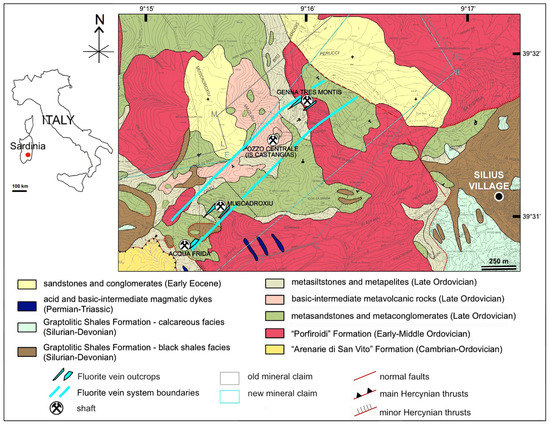
Figure 1.
Location and geological map of the Silius area (SE Sardinia, Italy), modified after [19].
The Silius veins are banded and show several generations of fluorite, carbonate minerals, galena, and quartz. The width of the veins ranges between 7–8 m in outcrop and 15–20 m in depth, where they are interconnected. The upper part of the vein system contains fluorite, barite, and galena with grades of 35%, 10%, and 3%, respectively; whereas in the lower zones, the amount of barite decreases dramatically, and the fluorite and galena grades can reach 50% and 6%, respectively [23,24]. Gangue carbonates containing REE-bearing minerals from the mineralized veins are composed of a mixture of sparry calcite (prevailing) and dolomite/ferroan dolomite/ankerite.
At Silius, the vein carbonates are generally far more enriched in REEs than fluorites. The most common REE mineral is the fluorocarbonate synchysite-(Ce), with an average formula corresponding to: Ca1.07(La0.19,Ce0.36,Pr0.04,Nd0.15,Sm0.03,Gd0.03,Y0.13)(CO3)2F [19]. This fluorocarbonate mainly fills the intergranular porosity in the carbonate matrix and forms aggregates with tabular habit and euhedral laths. The REE concentrations in synchysite vary to a large extent, i.e., (w/w percentages): La ranges between 6.58% and 13.03% La2O3, Ce occurs in an interval between 15.90% and 21.10% Ce2O3, and Y between 2.58% and 8.45% Y2O3 [19]. Xenotime-(Y), with minor contents of Dy and Yb (~3%; [9]), has been detected at Silius only sporadically, and also as a cavity lining among the carbonate crystals.
Because the processing method used for the extraction of fluorite and galena from the Silius run-of-mine (ROM) material basically consisted in applying flotation to the comminuted bulk ore, we concluded that most of the carbonate gangue (with their hosted REEs) had been discharged in the waste heaps from which our sampling was performed. In fact, the above-quoted mineralogy of the REEs was observed again in the carbonate-rich samples from the waste, notwithstanding the different granulometry on the material stacked in the mounds.
3. Materials and Methods
3.1. Starting Materials’ Description and Characterization
The materials analyzed in this research were represented by 10 bulk samples (10 kg) of carbonates, collected from the various waste mounds at the Assemini (Cagliari) site around the old processing plant. In Figure 2 are shown the sampling sites and the positions of the different mounds.
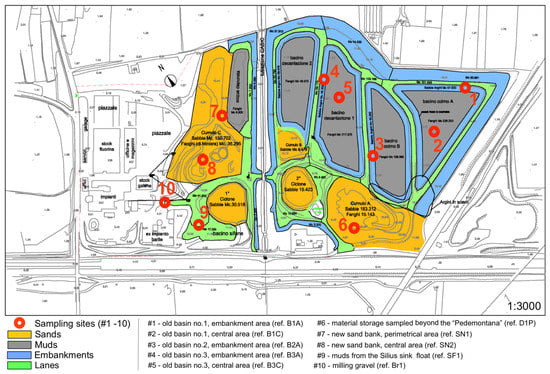
Figure 2.
The Assemini waste area. The red circles are the sampling sites, with related labels and description, modified after [25].
From the initial 10 kg of the weighted samples (Figure 3), ca. 1 kg was allocated for mineralogical and geochemical analyses and for the chemical extraction tests.
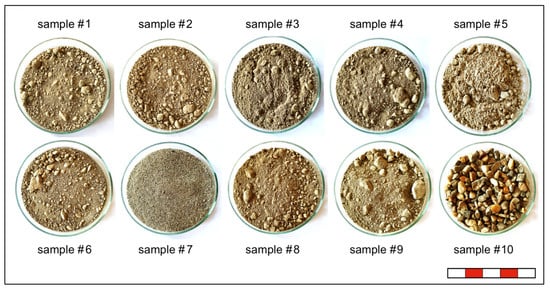
Figure 3.
The analyzed samples (bar scale = 10 cm).
The samples were first comminuted at a size less than 15 mm, mixed, and quartered for successive analytical procedures. Fractions of 100 g for each sample were previously washed with deionized water and then preliminarily characterized by qualitative X-ray diffraction analysis (XRD). The used instrument was a Seifert-GE ID3003 diffractometer (Dipartimento di Scienze della Terra, dell’Ambiente e delle Risorse—DiSTAR, Università degli Studi di Napoli Federico II, Italy) with CuKα radiation, Ni-filtered at 40 kV and 30 mA, 3–80° 2θ range, step scan 0.02°, time 10 s/step, the RayfleX (GE) software package, and the JCPDS PDF-2 database. A silicon wafer was used to check the instrumental setting, whereas the sample holder was a zero-background plate of quartz crystal, cut and polished at 6° of the c-axis.
For quantitative powder X-ray diffraction, the XRD instrument was a PANalytical X’Pert equipped with a high-speed PIXcel detector and a X’Pert data collector interface (Osservatorio Vesuviano, Istituto Nazionale di Geofisica e Vulcanologia, Naples, Italy). An internal standard (20% corundum Buehler) was added to the sample to quantify possible amorphous phases. The configuration of the XRD instrument included a Ni-filter, CuKα radiation, pyrolytic graphite crystal monochromator, 40 kV and 40 mA current, 3–70° 2θ range, and 0.02° steps with 8 s/step. Diffraction patterns were interpreted using the X’Pert High Score Plus software package 4.9 version. Data refining was processed by the GSAS package [26] and the EXPUGUI graphical interface [27]. The refining procedure was based on the agreement indices χ2, Rwp, and Rp.
About 20 g of each sample was pulverized at 200 mesh for whole rock analyses, i.e., major, minor, and trace (REE) elements. Analyses were carried out at the Bureau Veritas Commodities Canada Ltd. Laboratories (Vancouver, Canada). The protocol LF200 was adopted: major oxides and several minor elements were analyzed by ICP-OES following a LiBO2/Li2B4O7 fusion and dilute nitric digestion. Loss on ignition (LOI) was calculated by weight difference after ignition at 1000 °C. REEs and refractory elements were determined by ICP-MS following a LiBO2/Li2B4O7 fusion and digestion with HNO3. In addition, a separate volume split was digested in aqua regia and analyzed by ICP-MS to detect the precious and base metals.
Selected fragments were separated from the abovementioned fractions for secondary electron imagining by scanning electron microscopy (SEM) and energy dispersion spectrometry (EDS) investigations. Chips of carbonates, impregnated with Araldite D and Raku Hardener were prepared for polished thin sections EH 2950 (OMT Laboratory, Aosta, Italy). SEM analyses were carried out with a Jeol JSM 5310, equipped with the INCA X-stream pulse processor and the 4.08 version Inca software (Oxford Instruments detector) (DiSTAR, Università di Napoli Federico II, Italy), operating at 15 kV primary beam voltage, 50–100 mA filament current, variable spot size, and 50 s net acquisition time. The reference standards were as follows: albite (Si, Al, Na), orthoclase (K), wollastonite (Ca), diopside (Mg), almandine (Fe), rutile (Ti), barite (Ba), strontianite (Sr), eskolaite (Cr), rhodonite (Mn), pyrite (S), sphalerite (Zn), galena (Pb), fluorite (F), apatite (P), sylvite (Cl), Smithsonian phosphates (La, Ce, Nd, Sm, Y), pure vanadium (V), and Corning glass (Th, U). Analytical errors are 1% rel. for major elements and 3% rel. for minor elements.
3.2. REE Extraction
Quantitative extraction of REE from ores can be performed based on well-standardized procedures, deeply detailed in analytical protocols. In general, a suitable combination of mineral acids (in a single step or in a tailored sequence) is proposed (i.e., [8,14,28,29,30]). However, leaching of REE from fluorite, calcite, and dolomite, which are the main ore minerals extracted at Silius, may require a somewhat different strategy [17], due to the risk to have high acid consumption. An ideal approach should guarantee the use of green reagents, as well as easy applicability in the field, safe extraction procedures, and affordability. For this study, preliminary laboratory tests on the extraction of REEs from the samples were performed, leaching ROM material with both acid and alkaline solutions. Once separated from the solid residue, the liquid phase of each sample, after acidification (when necessary), was analyzed by ICP-MS for the REE content. The instrument used was an Aurora inductively coupled mass spectrometer M90 ICP-MS by Bruker Daltonics (USA) allocated at the Department of Chemistry (DICHI, Università di Napoli Federico II, Italy).
Several procedures were tested varying the composition of the contact solution and the temperature of the leaching stage. First, attempts with both gross alkaline and acid solutions were made. Acid leaching, performed using inorganic acids such as HCl, H3PO4, and H2SO4, led to a complete dissolution of the ore sample allowing the transfer in aqueous solution of many cations, including Fe3+, that had to be removed, through specific precipitation reactions, in order to have the selective recovery of REEs. On the contrary, a direct alkaline leaching of the ore sample using K2CO3 overcame the need of a multiple-step process. Moreover, analyzing the solutions after both acid (with H2SO4) and alkaline (with K2CO3) leaching processes and comparing the values of REEs extracted, it is clear that the alkaline leaching process leads to the highest REE recoveries (i.e., Nd 9.4 and 27.5 mg kg−1, respectively). This process is schematically presented in Figure 4.
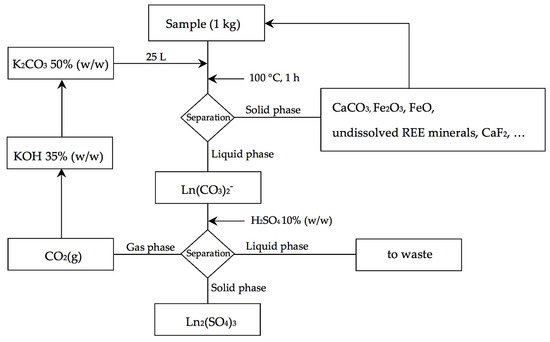
Figure 4.
Scheme of the proposed REE separation procedures.
Each sample, finely ground at 200 mesh, was treated with 50% K2CO3 at 100 °C for 1 h, under continuous stirring with air bubbling.
Among the minerals occurring in the waste, calcite, dolomite, and barite are poorly soluble in concentrated K2CO3.
However, in 50% K2CO3, transformation of gypsum to calcite is expected, based on the reaction
whose equilibrium constant is about 104, which means that low concentrations of carbonate would be sufficient to obtain a 100% conversion of gypsum. A similar reaction can be considered to occur on fluorite
CaSO4(s) + CO32− = CaCO3(s) + SO42−
CaF2(s) + CO32− = CaCO3(s) + 2F−
Though, in this case, the equilibrium constant is about 10−2, it may be easily evaluated that the carbonate concentration is high enough to quantitatively dissolve fluorite, forming calcite as well.
Alkaline pH favors quartz dissolution, with formation of soluble silicates
SiO2(s) + 2OH− = SiO32− + H2O
Atmospheric oxygen makes the mixture oxidizing enough to suppress the possible solubilization of Fe(II) in the form of carbonate complexes, as in reaction (4)
FeO(s) + 2CO32− + H2O = Fe(CO3)22− + 2OH−
To the contrary, in such conditions, the formation of Iron(III) oxy-hydroxide according to the reaction (5)
is thermodynamically favored.
4FeO(s) + O2(g) + 2H2O = 4FeOOH(s)
The core of the proposed method is in the increased solubility of lanthanides fluorocarbonates in concentrated carbonate solutions, due to the formation of very stable complexes between Ln3+ and CO32− ions [31,32,33]. Soluble species, such as LnCO3+ and Ln(CO3)2− are formed at neutral pH, while at alkaline pH and high carbonate concentration, the formation of carbonate-rich lanthanide complexes, such as NaxCeIV(CO3)6(8−x)− and NayCeIII(CO3)4(5−y)− has been demonstrated [34].
Leaching REE fluorocarbonates using a concentrated K2CO3 solution is advantageous. Instead of assuming the simple reaction
whose equilibrium constant is indicated as Ks, in carbonate-rich solutions, the formation of soluble CO32− complexes must be considered, through reactions such as
for which a constant β2 ≈ 1010 can be reasonably assumed [28]. The sum of reactions (6) and (7) gives reaction (8)
with a constant K = Ks × β2, consistent with an increase of about five orders of magnitude of synchysite solubility.
LnCO3F(s) = Ln3+ + CO32− + F−
Ln3+ + 2CO32− = Ln(CO3)2−
LnCO3F(s) + CO32− = Ln(CO3)2− + F−
Based on a similar reaction, Y(III), occurring as xenotime, is also solubilized (as in (9))
YPO4(s) + 2CO32− = Y(CO3)2− + PO43−
Then, soluble REE carbonate complexes are, at first, separated and concentrated, and hence precipitated as sulfates, using H2SO4
2Ln(CO3)2− + 8H+ + 3SO42− = Ln2(SO4)3(s) + 4CO2(g) + 4H2O
Carbon dioxide produced at this stage is bubbled in concentrated KOH to produce K2CO3, which can be re-inserted in the process.
A further leaching test with K2CO3 solution was carried out by a mineralization in microwave, considering 8 mL of 50% K2CO3 50%, 0.25 g of sample and maintaining a temperature of 90 °C for 1 h. The leached solution was analyzed by the Bruker Daltonics spectrometer M90 ICP-MS (DICHI, Università di Napoli Federico II, Italy).
4. Results
4.1. Mineralogical and Geochemical Analyses of Raw Materials
4.1.1. SEM-XRD
SEM-EDS data indicate, in accordance with recent literature [19,20], that the bulk samples representing the Assemini waste material contain REE minerals finely included within the carbonate minerals (mainly calcite and dolomite) and, to a lesser extent, also in quartz and fluorite (Figure 5 and Figure 6). Other minerals found sporadically by EDS are sulfides (pyrite, sphalerite, galena), ankerite, hemimorphite, cerussite, smithsonite, Fe-oxy-hydroxides, apatite, rutile, and zircon. In Figure S1 and Table S1, we report selected EDS spectra of minerals shown in Figure 5 and Figure 6 (with other miscellaneous minor to trace phases) and chemical analyses of synchysite-(Ce) in the bulk samples, respectively. Chemical data of other miscellaneous minerals can be found in [19].
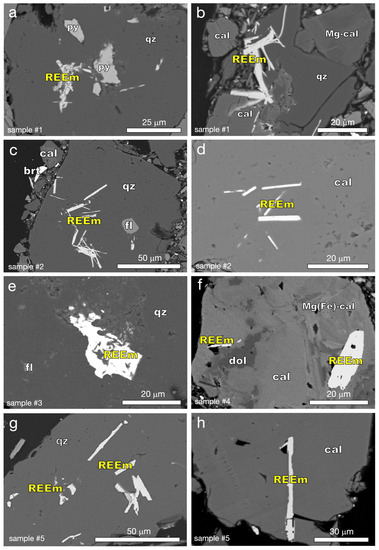
Figure 5.
SEM micrographs (backscattered electrons mode, BSE) of the analyzed samples #1 to #5 (polished sections). (a) Sample #1, REE-bearing minerals in quartz, together with pyrite. (b) Sample #1, laths of REE-bearing minerals both in quartz and in calcite. (c) Sample #2, lath-shaped REE-bearing minerals (with rounded fluorite) in quartz and (d) in calcite. (e) Sample #3, REE-bearing minerals in a quartz grain, which contains tiny fluorite inclusions. (f) Sample #4, subhedral to anhedral REE-bearing minerals in Ca(Mg-Fe)carbonates. (g,h) Sample #5, euhedral REE-bearing crystals in quartz and calcite grains, respectively. Selected EDS spectra of minerals detected in these samples are shown in Figure S1, whereas chemical composition of synchysite-(Ce), inferred by EDS microanalyses, are reported in Table S1. Symbols: REEm: REE-bearing fluorocarbonates [synchysite-(Ce)] and/or trace REE-bearing phosphates [xenotime-(Y)]; qz: quartz; cal: calcite; Mg(Fe)cal: Mg(Fe)-bearing calcite to ankerite; dol: dolomite; py: pyrite; brt: barite; fl: fluorite.
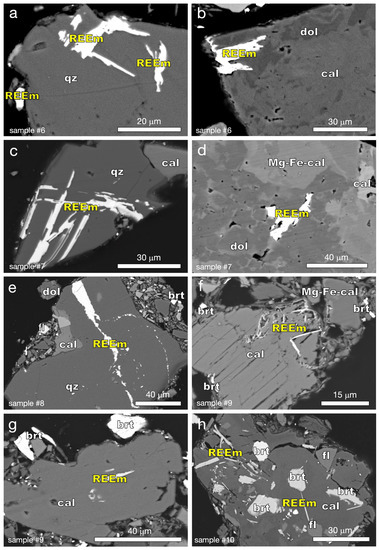
Figure 6.
SEM micrographs (backscattered electrons mode, BSE) of the analyzed samples #6 to #10 (polished sections). (a,b) Sample #6, euhedral to subhedral laths of REE-bearing minerals in quartz and in calcite-dolomite, respectively. (c,d) Sample #7, laths of REE-bearing minerals both in quartz and in dolomite, respectively. (e) Sample #8, large inclusion of REE-bearing minerals in quartz. (f,g) Sample #9, REE-bearing minerals in calcite grains. (h) Sample #10, lath-shaped REE-bearing minerals in a calcite fragment, also rich in barite and fluorite inclusions. Selected EDS spectra of minerals detected in these samples are shown in Figure S1, whereas chemical composition of synchysite-(Ce), inferred by EDS microanalyses, are reported in Table S1. Symbols: REEm: REE-bearing fluorocarbonates [synchysite-(Ce)] and/or trace REE-bearing phosphates [xenotime-(Y)]; qz: quartz; cal: calcite; Mg(Fe)cal: Mg(Fe)-bearing calcite to ankerite; dol: dolomite; py: pyrite; brt: barite; fl: fluorite.
The qualitative vs. quantitative XRD analyses show that the 10 samples basically consist of mixtures of calcite, dolomite, quartz, fluorite, muscovite, and barite. Other minerals such as K-feldspar, kaolinite, gypsum, and illite can occur in variable amounts. The results of quantitative XRD analysis are presented in Table 1.

Table 1.
Mineralogical composition (wt.%) inferred by quantitative XRD of the untreated waste materials from Assemini.
4.1.2. Whole Rock by ICP
The results of bulk chemical analyses carried out by ICP in the waste of Assemini are presented in Figure 7 and Table S2.

Figure 7.
Initial REE abundances in the analyzed bulk samples (see Table S2).
The most abundant elements were La, Ce, Pr, Nd, and Y (with a significant prevalence of Ce). The largest REE amounts were detected in sample 5 (Old Basin No. 3, Central Zone, ref. # B3C) and sample 9 (Silius Sink-Float muds, ref. # SF1). If we compare the mineralogical composition of samples 5 and 9 with the other samples inferred by quantitative XRD analysis (Table 1), it can be noted that sample 5 is richer in carbonates (calcite-dolomite, ~70 wt.%), while sample 9 is richer in fluorite (~23 wt.%); by summing the amount of carbonates and fluorite for samples 5 and 9, we obtain ~74 wt.% for the first one and ~53 wt.% for the second one, which are the two highest values obtained for the studied samples (see Table 1).
4.2. REE Extraction
A first stage of the present study was aimed to define the optimal solution/sample ratio, so as to find the right amount of mineral to be treated in order to obtain the maximum percentage of extraction. It turned out that 0.1 g of sample resulted in a concentration of REEs in solution far below the LOD of the instrument. The best option was to increase the amount of sample by an order of magnitude.
In order to increase REEs’ recovery, temperature is the determining factor. The range of temperatures investigated arose from 60 to 110 °C; 100 °C was considered an adequate compromise between reaction efficiency and applicability on site.
Each sample underwent the alkaline attack, as described in Figure 4 and in Section 3.2. The amounts of REEs extracted from the 10 samples through this chemical treatment are shown in the bar plot of Figure 8 and in Table S3.
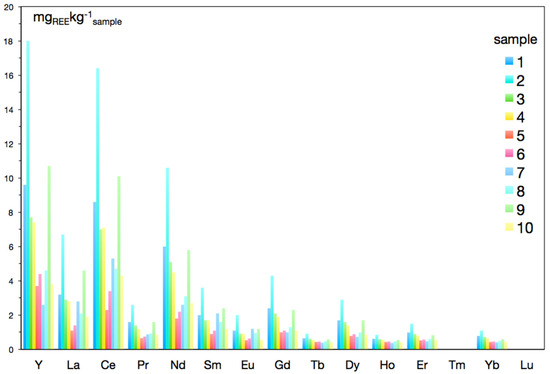
Figure 8.
REEs extracted in the analyzed samples (see Table S3).
The alkaline attack led to the leaching of the lanthanides bonded on the surface of the (micro)fragments. Indeed, SEM images (Figure 9a,b) show the untreated fragments (sample 5) with REE-bearing phases before the chemical leaching procedures, while Figure 9c,d shows the same sample after the alkaline attack. In the latter case, no residues of fluorocarbonates were detected on the grain surfaces. The XRD pattern of the treated sample also shows a general low grade of crystallinity, with the main reflections (with low intensities) likely attributable to trace contents of feldspar, muscovite/illite, and fluorite.
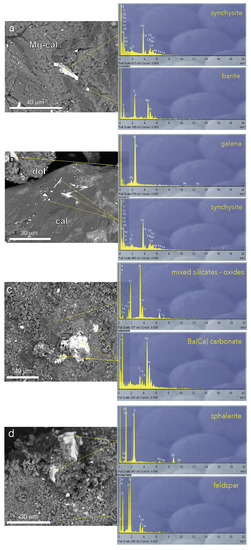
Figure 9.
Representative SEM images (backscattered electrons mode, BSE) and EDS spectra of sample 5 before (a,b) and after (c,d) the chemical leaching treatment (unpolished fragments). In the first two micrographs, the REE-bearing synchysite in carbonate phases is clearly observed, whereas in the second two images these minerals are not present. Symbols: cal, calcite; dol, dolomite; Mg-cal, Mg-bearing calcite.
The percentages of REE extracted, related to the ratio between the amount of extracted lanthanides using alkaline treatment (Table S3) and the initial REE contents (Table S2), are presented in Figure 10 and Table S4. We can observe that the REE percentages are not identical for each sample, presumably owing to their high mineralogical heterogeneity (see Table 1). Indeed, in some samples, especially in samples 1, 2, 3, 4, and 9, the percentage of REEs extracted in comparison with the initial REE amounts is higher than in the others (Figure 10 and Table S4).
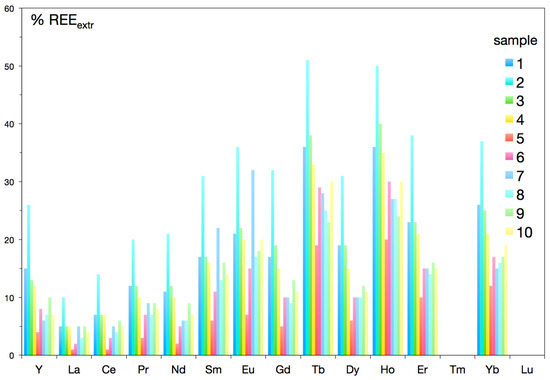
It seems also that minerals, which are more soluble in alkaline leaching solution used for the treatment, namely silicates and quartz, play a fundamental role in this extraction. Dissolution of quartz, favored at high temperatures, allows the release of fluorocarbonates included in its structure, making them available to form lanthanide–carbonate complexes in solution.
Experiments were performed also a second time on the residue of the first treatment, and a comparison between the amounts extracted from the first treatment (Table S3) and those gained from the second one on the same residue is shown in Table S5. This subsequent alkaline treatment on the residue led to extraction of the lanthanides internally bonded to the mineral, for a quantity higher or, at least, comparable to that gained from the first extraction.
We performed a further leaching test with the same alkaline solution (K2CO3 50%), using the method of microwave mineralization. This procedure led to recover REE amounts (Table S6) approximately in the same order of magnitude of the first procedure described above (Figure 4), even though with single concentration values of lanthanides were generally lower than those obtained with the first method.
Figure 11 shows, for example, the amount of cerium extracted by the alkaline treatment (a), the alkaline treatment on the residue (aR), and by the leaching test using the microwave mineralization (am).
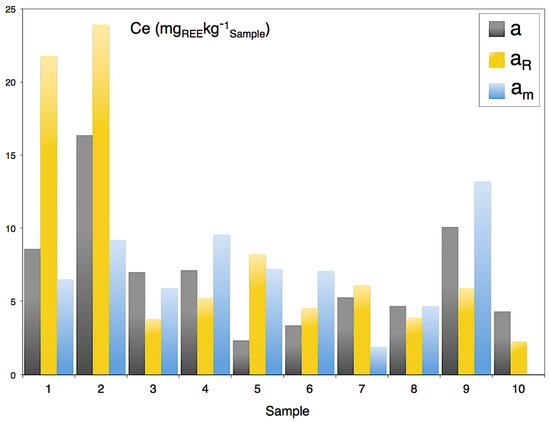
Figure 11.
Amounts of Ce extracted after the alkaline treatment of the samples (a) and after a second one on the residues (aR), following the procedure depicted in Figure 4 (see Tables S3 and S5). These values are also compared with those obtained from the microwave mineralization experiment (am), see Table S6.
5. Discussions and Conclusions
The sustainable management of Earth’s natural resources is one of the main goals of the 2030 Agenda of the United Nations for Sustainable Development. An indispensable requirement for sustainability is the practice of circular economy, based on minimizing waste and pollution and allowing materials to stay in use [35,36]. In the mining sector, circular economy and green economy are the most used concepts for sustainability issues ([17,18,37], and references therein). For the raw material sector, they are especially focused on the 3-R approach (i.e., reduce, reuse, and recycle), with the goal to minimize the waste material along a value chain and maintain the material as long as possible in the cycle of a system [37].
The proposed method of REE extraction from the mine wastes and tailings of the Silius mine was fully inspired by some of the goals of UN 2030 Agenda, as well as by the above-mentioned 3-R approach. To the author’s best knowledge, this is the first study of REEs’ separation from extractive wastes derived from a mining area that has been carried out on a real case study on the Italian territory. As regards the traditional mining areas of South West Sardinia, only a relatively recent study [38] exists on the definition of the mean concentration of 53 μg/L of REE in mine drainage waters (pH 6.2 to 7). The waters are flowing out from the tailings heaps of abandoned Zn–Pb–Cu mines located in the Ingurtosu district.
The present study has shown that the tailings and waste materials of the Silius fluorite mine contain variable amounts of REEs (avg. 368 mg∙kg−1 of total REEs), mainly hosted in fluorocarbonates and phosphates. This confirms previous studies conducted on the fluorite orebody and its gangue [19,20], which advanced the hypothesis that REE-bearing minerals could have been left in the waste during fluorite processing. In addition, it can be possible to highlight, as demonstrated by our mineralogical investigations, that REE-bearing minerals are chemically stable during the mineral processing. In fact, after dense media separation and flotation, they still occur in their original form.
Although the samples have a very fine grain size (10–30 micron), the mineralogical analyses allowed the determination that both fluorocarbonates and phosphates are not completely liberated from the quartz and carbonate gangue. This prevents their possible mechanical recovery, thus making necessary a hydrometallurgical technique. The grain size of REE minerals and their relation with the host matrix have two implications for the feasibility of REE extraction through aqueous solutions:
- (i)
- It is necessary to limit the solvent interaction with the carbonate gangue (that is the most abundant mineral phase in the sample).
- (ii)
- It is necessary to find ways to increase the particle surfaces exposed to chemical reaction.
The use of concentrated potassium carbonate solution allowed to assure the first point, being effective in the leaching from ROM material, at first, of the REE-bearing minerals (Figure 4) bonded on the surface of the minerals, and subsequently through a second alkaline attack on the same residue, of the lanthanides incorporated into the structure of the solid.
However, after the leaching treatment, the percentage of liberated REEs was lower than the total amount of REEs effectively occurring in the samples. This low efficiency can be explained considering the above-mentioned partially un-liberated nature of the REE-bearing minerals, which, in association with the selective reactivity of the alkaline solution, makes it impossible to dissolve particles locked in carbonates. This is partly balanced by the stronger reactivity of the minerals that are more soluble in the alkaline leaching solution used for the treatment, namely silicates and quartz.
The dissolution of minor quartz, favored at high temperatures, allows the release of the fluorocarbonates included in its structure, making them available to form lanthanide–carbonate complexes in solution. It must be noted that the treatment of the residue of the first extraction allowed the dissolution of an additional amount of REEs, clearly indicating that the initial solution can be easily/quickly saturated, thus preventing further REE extraction. The use of the microwaves, which was aimed to produce microfracturing of the particles and increase the exposed surfaces, did not cause a clear enhancement in metal extraction, whereas increasing the solution temperature was more effective.
The tests conducted for this research give significant information for a possible industrial upscaling (at least for a projected pilot plant) of REEs’ extraction in the Silius mine with the proposed method:
- -
- The small grain size of the REE-minerals can be a problem for their mechanical liberation: this issue must be fixed with appropriate milling or microfracturing techniques.
- -
- The repetition of the treatment by using new solutions allows the extraction of more REEs: potentially this could be performed by adopting a continuous flux through the mineralized material.
- -
- This study shows promising results to selectively extract REEs with respect to iron oxides from non-conventional sources such as fluorite ores and calcite/dolomite gangue.
- -
- As always in hydrometallurgical techniques, the increase of the temperature (up to 100 °C) favors metal extraction. This brings us to conclude that possible industrial REE extraction might be performed in variably sized tanks or silos—although it is not possible to exclude a priori the effectiveness of the heap leach.
- -
- The reuse of the reagents in a loop-like leaching process, where the CO2 (g) produced as a by-product of the REEs extraction is transformed in the K2CO3 leaching solution, allows the “circular” utilization of chemicals.
- -
- The REE-containing solution can be easily concentrated and processed through well-established procedures.
The effective industrial feasibility of the proposed method will pass through the above points. Further work is ongoing to scale up the process into a project of a pilot plant, in order to prove that the method developed within this research can be economically feasible, socially suitable, and environmentally respectful.
Supplementary Materials
The following are available online at https://www.mdpi.com/article/10.3390/su132414000/s1, Table S1: Chemical composition of synchysite-(Ce) found in the samples from Assemini, expressed in weight % of oxides (ΣREO, sum of REE oxides), Table S2: Initial REE abundances (mg∙kg−1) in the analyzed bulk samples. Table S3: REEs extracted (mg∙kg−1) in the analyzed samples. Table S4: REE extracted (% w/w) in the analyzed samples, Table S5: Comparison between the amount (mg∙kg−1) of lanthanides extracted after a first treatment (a) (as in Table S3) and a second one on the same residue (aR), for each sample, Table S6: REEs extracted (mg∙kg−1) in the analyzed samples by microwave mineralization. Figure S1: Selected EDS spectra of REE-bearing minerals shown in Figure 6, together with the spectra of other miscellaneous phases detected in the 10 analyzed samples from the old processing plant of Assemini (Cagliari, Italy).
Author Contributions
Conceptualization, G.B., N.M., E.V., C.M. and M.B. (Maria Boni); methodology, G.B., E.V., C.M., N.M. and M.T.; formal analysis, G.B., E.V., C.M., M.T., A.D.N., F.L., R.M., M.B. (Mariacristina Bianco) and A.M. (Angela Mormone); resources, G.B.; data curation, G.B., E.V., C.M. and N.M.; writing—original draft preparation, G.B., N.M., E.V., C.M. and M.B. (Maria Boni); writing—review and editing, G.B., N.M., E.V., C.M., M.B. (Maria Boni), A.M. (Antonio Marino), G.M. and A.M. (Angela Mormone); funding acquisition, G.B., M.B. (Maria Boni), A.M. (Antonio Marino) and G.M. All authors have read and agreed to the published version of the manuscript.
Funding
Fund no. 33282 2018 Regione Sardegna (Italy); Fund FRA—“Programma per il Finanziamento della Ricerca di Ateneo Linea B 2021”—Università di Napoli Federico II (Italy).
Institutional Review Board Statement
Not applicable.
Informed Consent Statement
Not applicable.
Data Availability Statement
Not applicable.
Acknowledgments
The authors thank the editor and the anonymous reviewers who provided very constructive comments and greatly contributed to the improvement of this manuscript. The financial support of FRA 2021 Linea B—Università di Napoli Federico II (Italy) and Regione Sardegna(Italy) is acknowledged. R. de Gennaro is thanked for assistance during SEM-EDS analyses. The authors thank all the staff of the “Fluorite di Silius” SpA for assistance during the fieldwork.
Conflicts of Interest
The authors declare no conflict of interest.
References
- Graedel, T.E.; Harper, E.M.; Nassar, N.T.; Reck, B.K. On the materials basis of the modern society. Proc. Natl. Acad. Sci. USA 2015, 112, 6295–6300. [Google Scholar] [CrossRef] [Green Version]
- Gunn, G. Critical Metals Handbook; John Wiley & Sons: London, UK, 2014; p. 454. ISBN 978-0-470-67171-9. [Google Scholar]
- Critical Raw Materials Resilience: Charting a Path towards Greater Security and Sustainability; European Commission: Brussels, Belgium, 2020; p. 23.
- The Raw Materials Initiative—Meeting Our Critical Needs for Growth and Jobs in Europe; European Commission: Brussels, Belgium, 2008; p. 14.
- Goodenough, K.M.; Schilling, J.; Jonsson, E.; Kalvige, P.; Charles, N.; Tuduri, J.; Deady, E.A.; Sadeghi, M.; Schiellerup, H.; Muller, A.; et al. Europe’s Rare Earth Element resource potential: An overview of REE metallogenetic provinces and their geodynamic setting. Ore Geol. Rev. 2016, 72, 838–856. [Google Scholar] [CrossRef]
- Wall, F. Rare earth elements. In Critical Metals Handbook; Gunn, A.G., Ed.; John Wiley & Sons: London, UK, 2014; pp. 312–339. ISBN 978-0-470-67171-9. [Google Scholar]
- Chakhmouradian, A.R.; Wall, F. Rare earth elements: Minerals, mines, magnets (and more). Elements 2012, 8, 333–342. [Google Scholar] [CrossRef]
- Balaram, V. Rare earth elements: A review of applications, occurrence, exploration, analysis, recycling, and environmental impact. Geosci. Front. 2019, 10, 1285–1303. [Google Scholar] [CrossRef]
- Kołodyńska, D.; Fila, D.; Gajda, B.; Gęga, J.; Hubicki, Z. Rare Earth Elements—Separation Methods Yesterday and Today. In Applications of Ion Exchange Materials in the Environment; Ahamed, I.M.I., Asiri, M.A., Eds.; Springer Nature: Cham, Switzerland, 2019; pp. 161–185. ISBN 978-3-030-10429-0. [Google Scholar]
- Gupta, C.K.; Krishnamurthy, N. Extractive Metallurgy of Rare Earths; CRC Press: Boca Raton, FL, USA, 2005; p. 484. [Google Scholar]
- Xie, F.; Zhang, T.A.; Dreisinger, D.; Doyle, F. A critical review on solvent extraction of rare earths from aqueous solutions. Miner. Eng. 2014, 56, 10–28. [Google Scholar] [CrossRef]
- Hu, Y.; Florek, J.; Larivière, D.; Fontaine, F.G.; Kleitz, F. Recent advances in the separation of Rare Earth elements using mesoporous hybrid materials. Chem. Rec. 2018, 18, 1261–1276. [Google Scholar] [CrossRef] [PubMed]
- Zepf, V. Rare Earth Elements—A New Approach to the Nexus of Supply, Demand and Use: Exemplified along the Use of Neodymium in Permanent Magnets; Springer Theses, Springer: Berlin/Heidelberg, Germany, 2013; p. 157. ISBN 978-3-642-35457-1. [Google Scholar]
- Peiravi, M.; Dehghani, F.; Ackah, L.; Baharlouei, A.; Godbold, J.; Liu, J.; Mohanty, M.; Ghosh, T. A Review of Rare-Earth Elements extraction with emphasis on non-conventional sources: Coal and coal byproducts, iron ore tailings, apatite, and phosphate byproducts. Min. Metall. Explor. 2021, 38, 1–26. [Google Scholar] [CrossRef]
- Zhoui, B.; Zhongxue, L.; Che, G. Global potential of Rare Earth resources and Rare Earth demand from clean technologies. Minerals 2017, 7, 203. [Google Scholar] [CrossRef] [Green Version]
- Communication from the Commission to the European Parliament, the Council, the European Economic and Social Committee and the Committee of the Regions on the 2017 List of Critical Raw Materials for the EU, 8p. Available online: https://eur-lex.europa.eu/legal-content/EN/TXT/PDF/?uri=CELEX:52017DC0490 (accessed on 9 November 2021).
- Lèbre, E.; Corder, G.; Golve, A. The role of the mining industry in a circular economy. A framework for resource management at the mine site level. J. Ind. Ecol. 2017, 21, 662–672. [Google Scholar] [CrossRef]
- Cotis, S.; Mueller, K.K.; Coudert, L.; Neculita, C.M.; Reynier, N.; Blais, J.F. Recovery potential of rare earth elements from mining and industrial residues: A review and cases studies. J. Geoch. Expl. 2021, 221, 106699. [Google Scholar] [CrossRef]
- Mondillo, N.; Boni, M.; Balassone, G.; Spoleto, S.; Stellato, F.; Marino, A.; Santoro, L.; Spratt, J. Rare earth elements (REE)-Minerals in the Silius fluorite vein system (Sardinia, Italy). Ore Geol. Rev. 2016, 74, 211–224. [Google Scholar] [CrossRef]
- Mondillo, N.; Boni, M.; Balassone, G.; Marino, A.; Arfè, G. Evaluation of the amount of rare earth elements -REE in the Silius fluorite vein system (SE Sardinia, Italy). Per. Mineral. 2017, 86, 121–132. [Google Scholar]
- Stoppa, F.; Pirajno, F.; Schiazza, M.; Vladykin, N.V. State of the art: Italian carbonatites and their potential for critical metal deposits. Gondwana Res. 2016, 37, 152–171. [Google Scholar] [CrossRef]
- United Nations Home Page. Transforming Our World: The 2030 Agenda for Sustainable Development. United Nations General Assembly 21 October 2015. A/RES/70/1. Available online: https://www.un.org/ga/search/view_doc.asp?symbol=A/RES/70/1&Lang=E (accessed on 9 November 2021).
- Natale, P. Il giacimento di Silius nel Gerrei. Boll. Ass. Miner. Subalp. 1969, 6, 1–35. [Google Scholar]
- Boni, M.; Balassone, G.; Fedele, L.; Mondillo, N. Post-Variscan hydrothermal activity and ore deposits in southern Sardinia (Italy): Selected examples from Gerrei (Silius vein system) and Iglesiente district. Per. Mineral. 2009, 78, 19–35. [Google Scholar]
- Balassone, G.; Boni, M.; Mondillo, N.; Vasca, E.; Manfredi, C.; Trifuoggi, M.; Di Nunzio, A.; Lombardo, F.; Mozzillo, R. Contenuti e separazione di terre rare (REE) in campioni della laveria di Assemini (Cagliari). Igea, S.p.A. Intern. Rep. 2020, 52. [Google Scholar]
- Larson, A.C.; Von Dreele, R.B.; GSAS. General Structure Analysis. Available online: https://11bm.xray.aps.anl.gov/documents/GSASManual.pdf (accessed on 17 December 2021).
- Toby, B.H. EXPGUI, a graphical user interface for GSAS. J. Appl. Crystallog. 2001, 34, 210–213. [Google Scholar] [CrossRef] [Green Version]
- Lyon, K.; Greenhalgh, M.; Herbst, R.S.; Garn, T.; Welty, A.; Soderstrom, M.D.; Jakovljevic, B. Enhanced separation of Rare Earth Elements. In Proceedings of the International Mineral Processing Congress, Quebec City, QC, Canada, 11–15 September 2016; ISBN 978-1-926872-29-2. [Google Scholar]
- Zhang, W.; Noble, A.; Yang, X.; Honaker, R.A. Comprehensive Review of Rare Earth Elements recovery from coal-related materials. Minerals 2020, 10, 451. [Google Scholar] [CrossRef]
- Arrachart, A.; Couturier, J.; Dourdain, S.; Levard, C.; Pellet-Rostaing, S. Recovery of Rare Earth Elements (REEs) Using Ionic Solvents. Processes 2021, 9, 1202. [Google Scholar] [CrossRef]
- Ciavatta, L.; Ferri, D.; Grenthe, I.; Salvatore, F.; Spahiu, K. Studies on Metal Carbonate Equilibria. 3. The Lanthanum(III) Carbonate Complexes in Aqueous Perchlorate Media. Acta Chem. Scand. A 1981, 35, 403–413. [Google Scholar] [CrossRef] [Green Version]
- Ferri, D.; Grenthe, I.; Hietanen, S.; Salvatore, F. Studies on Metal Carbonate Equilibria. 5. The Cerium(III) Carbonate Complexes in Aqueous Perchlorate Media. Acta Chem. Scand. A 1983, 37, 359–365. [Google Scholar] [CrossRef]
- Salvatore, F.; Vasca, E. Oxidation of Cerium(III) in aqueous carbonate solutions. J. Coord. Chem. 1990, 21, 237–246. [Google Scholar] [CrossRef]
- Dumonceau, J.; Bigot, S.; Treuil, M.; Faucherre, J.; Fromage, F. Determination of formation constants of tetracarbonatolanthanidates(III). Rev. Chim Min. 1979, 16, 583–592. [Google Scholar]
- González-Sánchez, R.; Settembre-Blundo, D.; Ferrari, A.M.; García-Muiña, F.E. Main dimensions in the building of the circular supply chain: A literature review. Sustainability 2020, 12, 2459. [Google Scholar] [CrossRef] [Green Version]
- Garcia-Muiña, F.E.; González-Sánchez, R.; Ferrari, A.M.; Settembre-Blundo, D. The paradigms of industry 4.0 and circular economy as enabling drivers for the competitiveness of businesses and territories: The case of an Italian ceramic tiles manufacturing company. Soc. Sci. 2018, 7, 255. [Google Scholar] [CrossRef] [Green Version]
- Dold, B. Sourcing of critical elements and industrial minerals from mine waste—The final evolutionary step back to sustainability of humankind? J. Geochem. Explor. 2020, 219, 106638. [Google Scholar] [CrossRef]
- Medas, D.; Cidu, R.; De Giudici, G.; Podda, F. Geochemistry of rare earth elements in water and solid materials at abandoned mines in SW Sardinia (Italy). J. Geochem. Explor. 2013, 133, 149–159. [Google Scholar] [CrossRef]
Publisher’s Note: MDPI stays neutral with regard to jurisdictional claims in published maps and institutional affiliations. |
© 2021 by the authors. Licensee MDPI, Basel, Switzerland. This article is an open access article distributed under the terms and conditions of the Creative Commons Attribution (CC BY) license (https://creativecommons.org/licenses/by/4.0/).